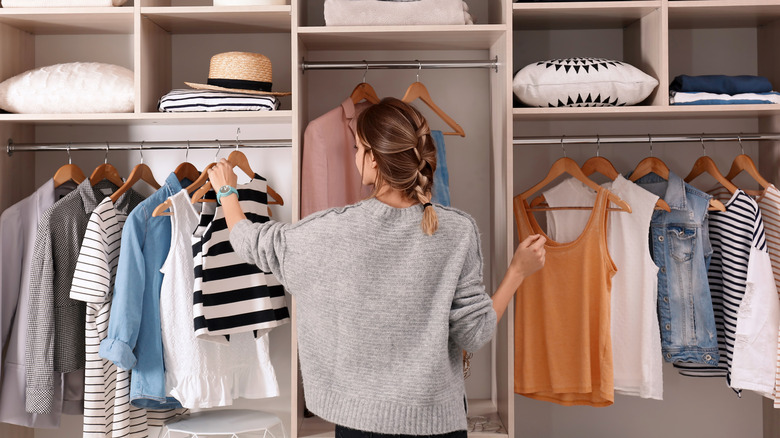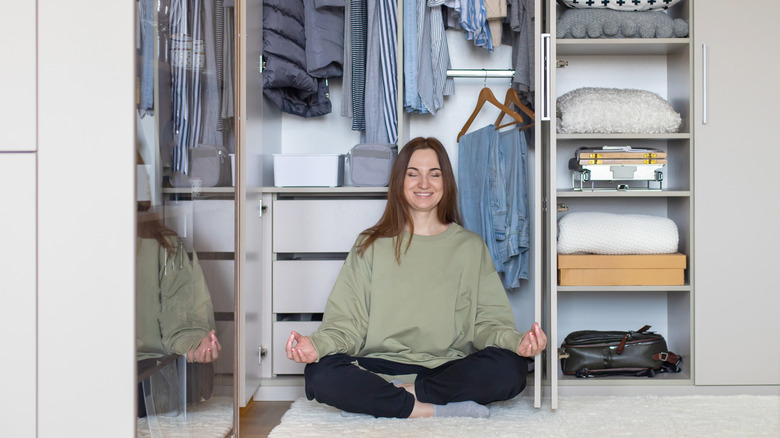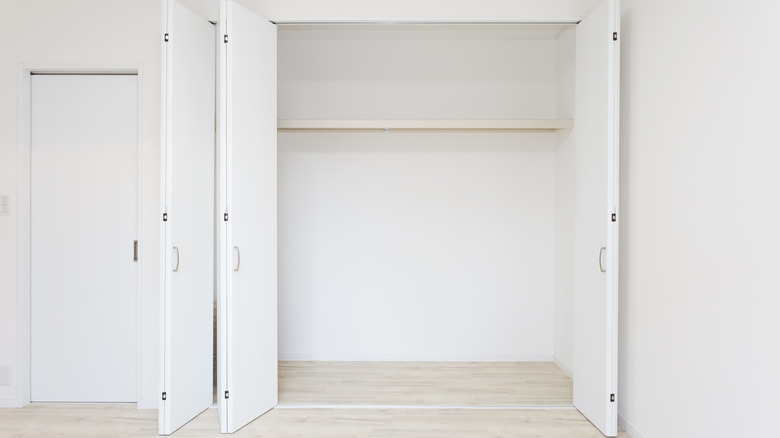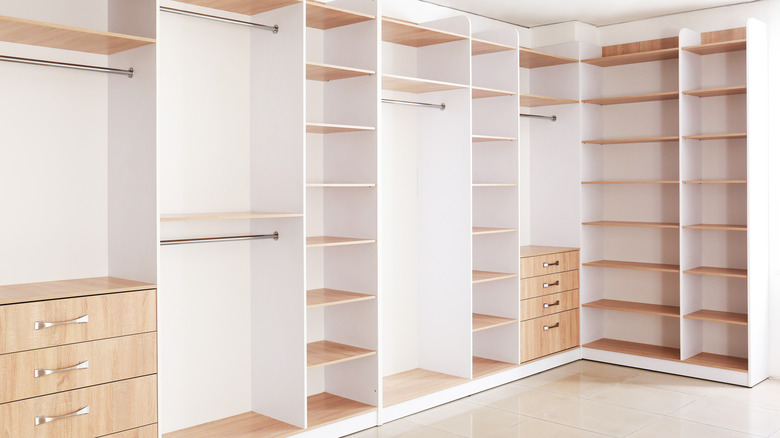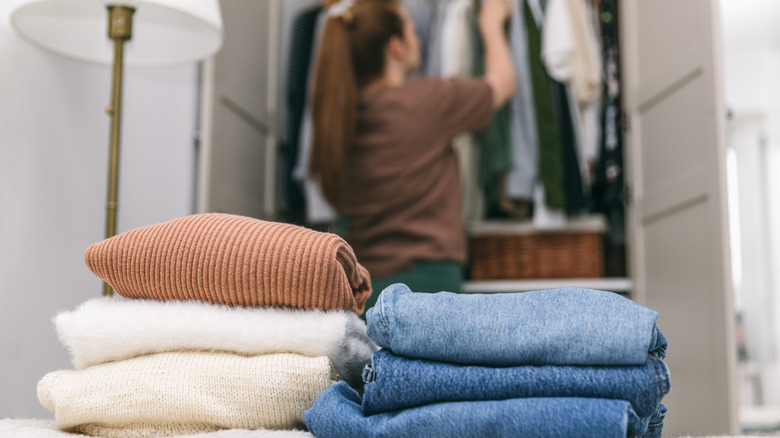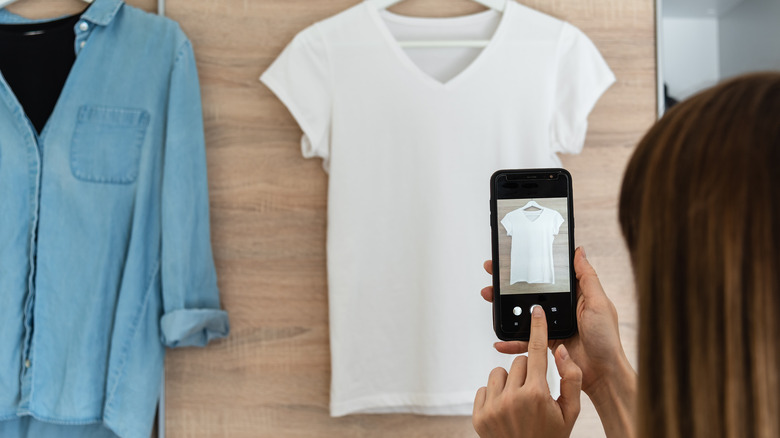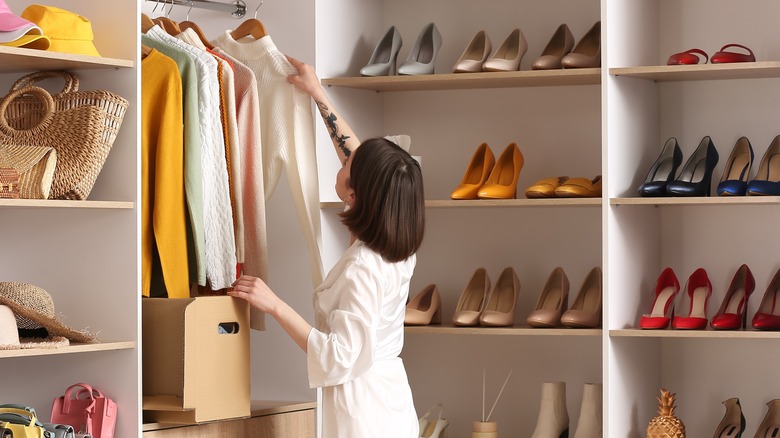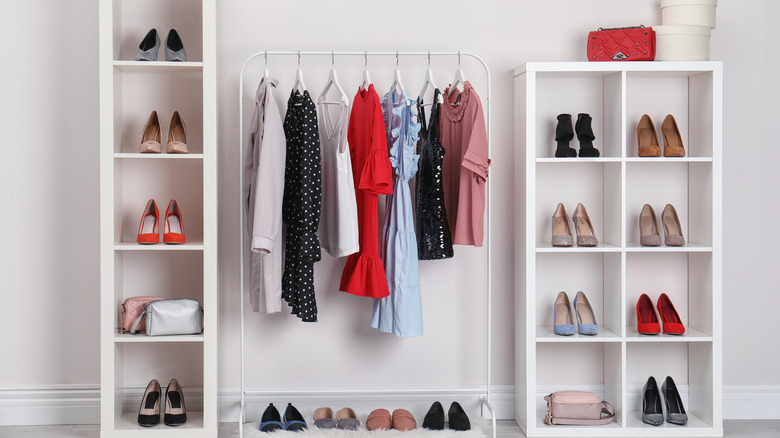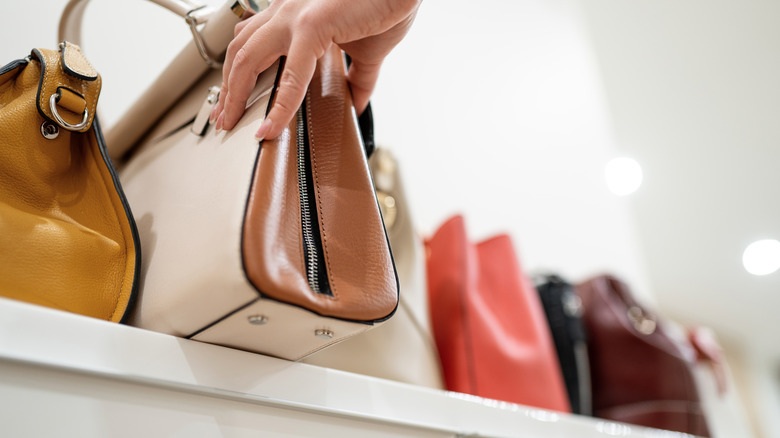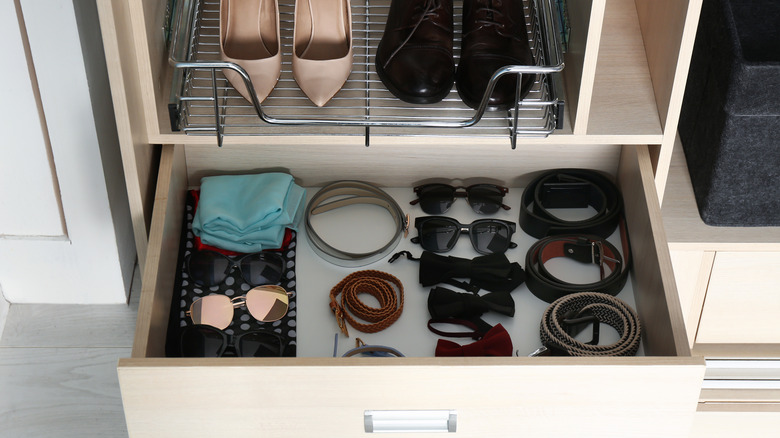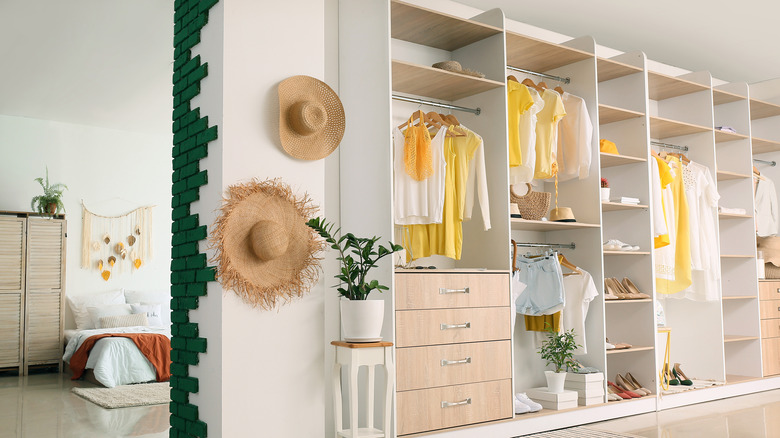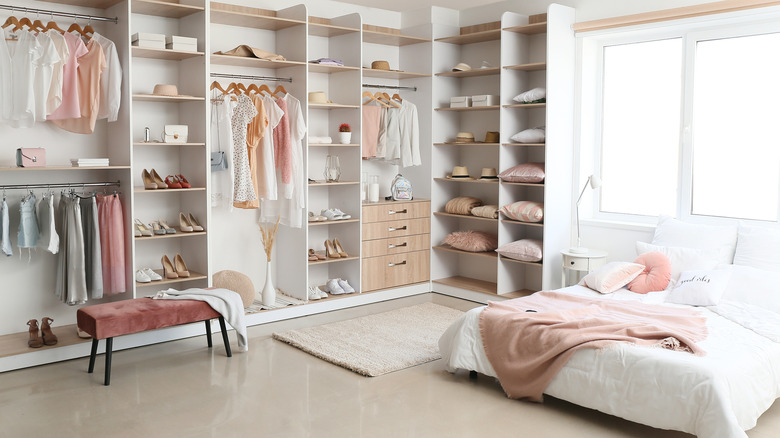15 Ways To Declutter And Organize Your Closet
We may receive a commission on purchases made from links.
In an ideal world, our homes would be spotless and organized at all times, but we unfortunately don't live in a perfect world. This means that we need to take decluttering into our own hands. After all, your latest online clothing order isn't going to put itself away, and it might be time to rotate your clothes for the new season. We're all guilty of letting our closets go at times, but the good news is that decluttering them is a tangible goal that can bring very real relief. According to Psychology Today, research has linked clutter with mental health issues like increased anxiety, so getting your closet under control could lift some weight off of your shoulders.
Of course, decluttering also means that you might find items you'd forgotten you even owned. Don't you have a pair of relaxed-fit mom jeans somewhere in your closet? Speaking of which, whatever happened to that greige cold-shoulder sweater you always used to wear? Well, they're in that closet — somewhere. Your mission, should you choose to accept it, is to declutter and organize it so that you can look and feel your best, and we've got 15 tips to get you there.
Set an intention to guide your closet organization
Decluttering and re-organizing your closet can feel like an enormous undertaking. Among other things, it will require that you confront numerous past decisions that you might find questionable in the light of the present. Nor are we talking just about shopping decisions but also the life decisions and life circumstances that prompted you to make those shopping decisions, per Graceful Spaces. That's bound to bring up some feelings in you, but you'll have an easier go of it if you start by taking some time to set an intention, per Elegant Simplicity.
To be clear, setting an intention is not the same as setting a goal, per Intelligent Change. A goal refers to a specific desired result such as, in this case, having a well-organized closet. An intention, by contrast, involves considering what a well-organized closet means to you in your life, as opposed to some rigid notion of what a well-organized closet should look like.
So, for example, if you're hoping that by organizing your closet, you'll be able to make better use of the clothes you like, then set that as your intention, and let that guide you. Alternatively, if you're hoping that by organizing your closet, you'll feel less anxious when you have to decide what to wear each day, then you could set that as — or among — your intentions. And yes, multiple intentions are fine; just set them and keep them in mind.
Take a good hard look at what kind of closet you're actually working with
As you set your intention, it can help to be mindful of the actual closet that you're about to work with. Closets come in all shapes and sizes, from the tiniest which have only enough room for you to reach in and grab what you need to those that are essentially rooms, per Harkraft. If your closet is closer to the former category, your options for shelving and drawers will be limited accordingly. If your closet is of the large, walk-in variety, it may be enough space to store your entire hanging wardrobe, in addition to all the clothes that you like to keep folded. as well as all your shoes, handbags, and other accessories.
No matter the size and shape of your closet, you'll want to start by calculating how much horizontal hanging space you have to work with. So, measure the height and width of each wall, and then keep these rules in mind regarding the use of those walls for hanging garments: A dress requires 2 to 3 horizontal inches, via BHG and Only Hangers, and a shirt requires about 1 inch. Garments you fold over the hanger need slightly more, around 1.25 and 1.5 inches. Further, a hanger requires about 24 inches of depth. A single hanging rod should be around 69 inches from the floor, per Bob Vila, and double-hanging rods should start at no fewer than 82 inches from the floor.
Best practices dictate starting with a clean and empty closet
Preliminaries accomplished, it's time to empty that closet out — completely, per CNET. Ideally, you'd take everything out and place it into a pile or piles on the floor, according to Dumpsters, which presumes that you'll be starting and finishing your closet cleanse on the same day. If that's not possible, then here is where your intention setting comes in handy. Instead of emptying your closet out all at once, you can work in batches, starting with dresses or pants or whichever feels right for you. You might also consider visualizing your closet as a series of vertical columns and tackling the columns one at a time.
The benefit is twofold. First, you'll be taking your clothing out of its familiar context, which will let you see them in a different context. As CNET points out, "now, you can be thoughtful and mindful about each piece you decide to keep." Second, you'll be able to deep-clean your closet, which Closet Works points out you should really be doing on something of a regular basis so as to control, at a minimum, the dust that you've brought in from outside. CNET recommends vacuuming floors and baseboards and dusting all surfaces (including shelves and hanging bars).
Nothing like starting fresh, no? Speaking of which, best closet practices dictate that after all that decluttering and organizing, you'll honor your hard work by placing only clean items back in there. You've got this.
Take an inventory of everything in your closet
While you are removing the items from your closet, you'll want to take inventory, according to Apartment Therapy, which maintains that "a closet inventory is more than just a cleverly disguised way to declutter your closet (though it is that, too). It's a way to get a handle on your wardrobe so that future shopping and dressing is easier." Even if that was not one of the intentions you set at the outset for your closet organization project, perhaps it's worth considering, nevertheless, because it could save you enormous time, not to mention money (unless you have a legitimate reason for, say, having three pairs of near-identical jeans at your disposal). Also, a closet inventory is really the first step in your eventual, inevitable closet purge, which you know is coming (more on that in just a bit).
Apartment Therapy recommends starting with two large boxes, one labeled "maybe" and the other labeled "donate." But "no" might work just as well if you're planning on selling or consigning any of your inventory. After emptying out your closet or sections thereof, divide the items into one of these two boxes just by sight alone. The ones that end up in the "donate" or "no" box are those that you don't even need to try on to know whether or not they're keepers. This puts an immediate stop to these items taking up space — in your closet and in your mind.
This is where the closet purge really gets going
So, here you are with all the items in your "maybe" box still to deal with. It's the maybe box that you'll be focusing on as you commence what's come to be known as a closet purge. Before getting started with the purge, Apartment Therapy recommends making a list of what you believe are your essential and desired clothing needs, using sub-categories in the quantities that make sense to you. So, for example, while many people will want to have X number of jeans, if you tend to live in jeans, your list may specify X number of wide-leg jeans, X number of skinny jeans, X number of black jeans, X number of white. As you start to purge, you can use this list to keep track of what you will still have when all is said and done.
In terms of purging methodology, some closet organization experts suggest keeping only what you've worn in the past year, per Camille Styles. Many experts suggest getting rid of anything that no longer fits or is beyond repair, per The Everygirl. But that could include, say, your wedding dress, for example, and if having it around brings you joy, then some experts, including Marie Kondo, believe it's worth keeping (via Financial Samurai). Whatever your methodology, when you're done purging, you should be left with those things that you still have use for — whether practical or emotional, per your personal intentions.
Do some good, make some cash, or both
In case you need a bit of an incentive to get rid of the various items that you have determined are no longer of use to you, you may wish to consider that what's not useful to you may, nevertheless, be very useful to someone else. If you want to put a dollar sign to it, and it's perfectly understandable if you do, you'll be happy to know that donations of clothing to accredited charities are generally deductible against your taxable income, per Goodwill of Central Coast.
Further, some of the clothing in your closet may even be capable of being resold — for money, and while that may seem, at first blush, to be less oriented toward the public good, Tailored makes several compelling arguments to the contrary, including that doing so ultimately helps curb waste of natural resources. And, moreover, to the extent that you're stocking the inventory of small retailers, you're helping support job creation.
Tailored's non-exhaustive list of ways you can make put your used clothes to good use includes donating to consignment shops and high-end thrift shops, making charitable donations to charities registered as 501(c)(3) as defined by the IRS, participating in online consignment (e.g., via the Real Real), and managing peer-to-peer resale — whether online or otherwise. For all items that can't be donated or sold for whatever reason, upcycling, which in this case refers to repurposing old items of clothing for new uses, per Fashion and Textiles, is always smart.
Reconsider how much hanging space you really need
Because even the most minimal closets in any given home will still have a hanging bar, it's natural to regard your clothing closet as synonymous with hanging space. However, how much of your closet should ideally be allotted to hanging space really depends upon your own clothing and your own preferences. According to MarthaStewart.com, non-negotiable hanging items include items made from flowy or wrinkle-prone fabrics, and structured clothing such as jackets, pants, and blouses, dresses, and outerwear. Of these, only a few really require the five or so feet of vertical length you get from a single hanging rod (via Bob Vila), namely dresses and long jackets and coats.
This is where your having taken inventory will come in handy. Once you have completed your purge, you should have an accurate sense of exactly how many of these items you have. Count them, and calculate how much tall vertical hanging space you need for them. For everything else, it's really all about your preferences, albeit as limited by your space constraints. For example, you might consider double-hanging rods, with the top rod holding tops and the bottom rod holding skirts and folded pants. Or if you prefer to see your t-shirts, sweatshirts, and/or sweaters in neat piles, as they have them at the Gap, for example, you may be able to use all of the rest of your space for shelves, per Jena Hall Designs.
Invest in the right hangers
Once you've decided how much hanging space you need, whether via single- versus double-hanging rod, your best closet decluttering and organizing efforts will benefit from your investment in the right hangers, according to Jena Hall Designs, which describes the right hangers, generally, as those that are "sturdy." This, of course, rules out wire hangers and many of the hangers that come with your clothing purchases. However, beyond "sturdy," here's what else you will want to consider. According to Closets by Design, "things aren't necessarily one-size-fits-all when it comes to hangers. Different hangers have different purposes and are best used for specific types of clothes." Accordingly, having the right hangers means having not just one kind of hanger.
For example, plastic hangers, which are relatively inexpensive, are fine for tops made of lightweight fabrics that aren't likely to stretch. But plastic hangers can be slippery, which means your clothes can end up falling on the floor. Felt and velvet hangers do a better job of holding onto your clothing, and they tend to be cut in a slimmer line than most plastic hangers. They do tend to cost more than plastic hangers, as do wood hangers. Closets by Design considers wood hangers to be the gold standard of hangers because they're not only built to last, but they are available in shapes that can preserve your clothing's structure. In addition, wood hangers tend to stand up well to your heavier items such as jackets and jeans.
Get your shoes off the floor
Generally speaking, your shoes belong on the floor. In your closet, however, shoes on the floor take up what is, for many closets, a disproportionate amount of much-needed floor space, and not efficiently either. In most cases, and even in closet spaces with relatively generous proportions, the most efficient solution to shoe storage will always involve the use of vertical space. In other words, shelves of some kind or another, whether built-in or brought-in.
To get the most efficient use of your horizontal space, you can store each pair heel-to-toe to one another, per Simplify You. The Container Store goes a step further and recommends, to the extent that you do have the space, using see-through shoe boxes that open from the front, as these protect your shoes from dust while still offering visibility and access. For shoes that you've decided to keep but which you only wear occasionally, another option is to place them on a high shelf in these containers.
A good space-saving option for shoe storage is a hanging shoe rack — one that hangs over the back of your closet door or one that hangs via hanger over your hanging rod. For boots, there are boot hooks. For even more limited space, you can make more efficient use of floor space by using portable, stackable shoe cubbies that start at the floor and go as high as the bottom of your hanging items.
Treat your handbags right
Proper storage can help extend the life of handbags, according to Apartment Therapy. As with shoes, shelves are the most user-friendly option because you'll be able to see your bags displayed just like you do in some retail stores. Also as with shoes, there are many other alternatives that work nicely to help you keep your closet organized and clutter-free. These include installing hooks on the backs of doors or on free wall space that does not otherwise offer a hanging-space alternative due for whatever reason, including a lack of the required 2 feet of depth (via BHG and Only Hangers).
Another option is installing vertical racks up and down the back of your closet door, to which you can attach wire baskets, using wire racks you can pick up from The Container Store. Hanging basket configurations like this are particularly useful for storing smaller bags and bags that don't have handles or straps from which they can be hung. If you're already using the back of your door for storing, say, your shoes, you can also use handbag organizers that hang from your closet's hanging rod, per Target.
For luxury handbags (and, theoretically, for any handbag that you care about and wish to have for the long term), Christie's auction house recommends stuffing them to help them keep their shape. You can use acid-free paper for this, but repurposing old clothing for this purpose is also an option.
Tightening up your belt storage can be a cinch
By the time you get through your closet purge, there's a decent chance that you've whittled your belt collection down to the few you wear with regularity. The ones with buckles will be the easiest to organize because you can simply purchase a belt organizer that hangs from your closet's hanging rod and uses the belt's buckle as a built-in hanger, per Closet Works. If you want something a little fancier, you can opt for a pull-out belt rack that fastens to the wall at roughly the same level as your closet's hanging rod. Some include as many as six hooks for belts, which could take care of your entire collection.
According to Uncluttered Simplicity, hanging storage is the way to go for leather belts because this eliminates any bend that could distort the belt's structure. What you don't want to do is to hang all your belts from a single ring because you'll this restricts your easy access to the one that's on top, per Naples News.
For belts that cannot be hung for whatever reason, including the absence of a buckle, your other option is to store them on shelves or in a drawer (if you're fortunate to have drawers in your closet). Storing a belt flat serves the same structural purpose as hanging belt storage. To conserve space, however, you may wish to roll your belts and keep them on shelves or in drawers.
Top it all off by organizing your hat collection
Between bad hair day hats, souvenir hats, and that hat that makes you feel like a duchess, or perhaps like Hailey Bieber, who appears to have developed a penchant for the chapeau of late, per StyleCaster, there's a pretty decent chance that even if you don't wear a hat every day, your closet purge left you with some number of hats that you affirmatively care about keeping.
For your baseball caps, it's perfectly fine to stack them one inside the other (the ones that match in size and shape) on a shelf or in a drawer. The same is true for trucker hats. For these as well as for newsboys and berets, you can also store them using strategically placed hooks on the walls of your closet, or on your closet door, if you're not using your closet door for storing shoes or handbags, per Closet Works. The same can be applied to hats that possess enough structure that hanging them won't change the shape over time, such as the straw hats seen above. Another option for hanging hat storage is a rack with multiple hooks.
In all cases, Closet Works recommends looking for "good quality metal hooks." For hats that require more delicate treatment to help maintain their shape, it's best to use a hat box. You can even use a hat box to hold your entire collection of seasonal wool caps separated by acid-free tissue (via Guardian Self Storage).
If you're still short on space, consider alternatives
So far, all of our advice on closet organization has presumed that you actually have a closet that you aren't using for some other purpose. Our advice has also presumed that everything that you want to fit in your closet actually fits in your closet. However, both presumptions may be more than just a bit fantastical when you consider that 49% of Americans say they would give up sex if it meant more closet space, according to a 2018 Makespace survey (via Clutter). And that doesn't even include the people that, presumably, feel pressed for closet space but, nevertheless, would not trade sex for more of it.
To the extent that your closet space is limited, all of the aforementioned tips still apply, but you may have to choose which of them to deploy within your closet, as opposed to elsewhere, the first and most obvious of which would be elsewhere in your bedroom. As shown above, clutter-free closet organization does not necessarily even require a closet at all. Whatever you can do in your closet, you can do outside of it, the primary difference being that you'll need to build or bring into your room any hanging racks, shelves, and other storage features you want. And to the extent you're still pressed for space, you can think outside the bedroom. After all, what are blazers if not outerwear? And how else to hang them alongside your wool cap collection?
Stow away seasonal garments
While you might be tempted to keep all of your clothing in one spot because it seems convenient, it's really not necessary and could clutter up your closet space. Things like bulky coats and thick sweaters can quickly take up precious real estate in your closet and make it harder for you to find your swimsuits or display all of your favorite lace slip dresses.
To maximize your closet space, bulky winter clothes can be stowed away during warmer months, like under your bed, in your attic, or in any other spaces you use for storage. The same goes for storing your short shorts, cropped tanks, and other warm-weather favorites during the winter. Plastic storage bins, vacuum-sealed bags, and clothing storage bags are all great options for keeping your out-of-season garments and accessories safe and organized.
Of course, if you live somewhere where the weather fluctuates a lot and you find yourself wearing shorts one day and sweaters the next, then keeping a wider range of garments in your closet makes complete sense. The main idea is to find ways to keep your closet space free for the things you wear the most.
Make decluttering a regular habit
One of the best ways to keep your closet decluttered is to make it a regular habit. Of course, that doesn't mean you need to keep yourself in a constant state of decluttering, but stopping to assess your closet space regularly can help you tame the mess before it gets out of control. Not only does it make getting dressed easier but it can seriously cut down on your stress levels. In fact, Dr. Robert London, a mental health professional in New York City, told Pickup Please, "Clutter leads to anxiety, embarrassment, family stresses... When you relieve the problem and learn how to throw things away, you feel better."
While too much clutter can lead to stress, feeling pressure to toss pieces you love just to make space isn't ideal, either. As such, it helps to know how often you need to organize your clothes, as "regular" decluttering means something different to everyone. This is why you should follow a pattern that works for you. For example, if you love to stay on top of trends and have accessories and outfits for each season, decluttering at the end of each season probably makes the most sense. However, if you wear many of the same staple pieces year-round, decluttering once a year is likely all that's needed to keep your closet organized and easy to use.
